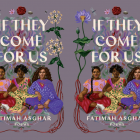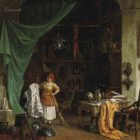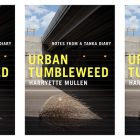The Colonizer and The Ghost

An article in CNN’s online travel section published last month describes an on-going phenomenon in Southern Italy: artifact theft and resulting ancient curses. “I am now 36 and had breast cancer twice,” says an American tourist to the staff of Pompeii’s Archeological Park. “We’re good people and I don’t want to pass this curse on to my family or children.” The tourist had stolen some artifacts from Pompeii when she visited the site in 2005, then, years later, returned them, along with her note of regret. “I wanted to have a piece of history that couldn’t be bought,” the woman admitted. She’d longed to possess a piece of that time, that place. And she isn’t alone. There have been, in fact, so many notes of regret, so many confessions, so many curses and returned artifacts, a museum has been erected to house them all.
Museums are filled with ghosts, if ghost is just another word for longing. Their collections typify our desire for possession, which, as poet and essayist Mary Ruefle would argue, is a “sickness”—the “world’s greatest sickness on earth,” in fact. It’s a sickness she grapples with while “playing hooky” from school as a sixteen-year-old student in Brussels. She “took a tram to the outskirts of the city and wandered through that marble mausoleum commonly called the Congo Museum,” a monument to Belgium’s colonial exploits in Africa during the late nineteenth and early twentieth centuries, going there so often, she tells us, “I could enter the museum blindfolded and turn exactly the right corners, one after the another” in order to reach what becomes the metaphorical heart of Ruefle’s 2016 collection My Private Property, or, rather, the head of it—a shrunken head she describes as “as close to a real doll as one could ever come.”
Sociologist Jean Baudrillard argues that “the indigenous object fascinates by means of its anteriority. This anteriority is characteristic both of the exotic object’s form and its mode of fabrication and links it to the analogously anterior world of childhood and its toys.” In the context of Belgium’s Congo Museum, the shrunken head becomes, to the viewer, a sort of toy left behind by a culture that they perceive to be stuck in a perpetual “childhood,” while the viewer’s culture, which stole the doll, cataloged, and displayed it, is perceived to be marching deeper into maturation, having abandoned childhood’s playthings in lieu of cultural theft, colonial plunder, and conquest: the games of adulthood. In “My Private Property,” Ruefle finds herself at a point of transition—from childhood to adolescence—when one stops playing with toys and starts playing with people. In the shrunken head, sixteen-year-old Ruefle may have sensed her rapidly-diminishing childhood, understanding in retrospect that “[the head] is both a child’s toy and an adult toy—it’s another person, after all.” She tells us, “I was not then, nor am I now, immune to the charms of having someone else to play with.”
Ruefle is making an implicit connection between childhood’s impulse toward play and adulthood’s penchant for manipulation. We miss our childhood toys. We long for them, and it’s out of this sense of longing, loss, and distance that the colonizer colonizes, wanting, as Ruefle argues, “someone” to play with and possess in the way a doll is possessed. Once eradication has taken place, the colonizer creates his museum and fills it with souvenirs of decimated cultures—with their ghosts. After all, “[t]he . . . world of the souvenir is a world of nature idealized,” poet and critic Susan Stewart says. “The souvenir is used most often to evoke a voluntary memory of childhood . . . or in the larger antiquarian theme of the childhood of the nation/race. This childhood is not a childhood as lived; it is a childhood voluntarily remembered, a childhood manufactured from its material survivals,” like the shrunken head Ruefle describes as “dangling from an invisible thread, much as a spider does, from the top of a glass case taller than I was.”
She goes on to describe the shrunken head as “the size of an orange. . . . He was particular and unique and human and utterly real, a man with eyes and eyelashes and hair. It was only later that I learned that the hair and eyelashes do not shrink with the flesh of the face, and so the shrunken often have the luxurious eyelashes of a child.” Ruefle, who at sixteen is “not much the other side of dolldom,” sees her own receding childhood in the head—in its “luxurious eyelashes,” its “beautifully shining” eyes—and by some odd reversal, in imagining the gruesome practice of the head’s creation, Ruefle finds love as well as possession, wondering at the inevitable relationship between the two. “I don’t remember what we communed about,” she says, “but he possessed me as I possessed him, and to possess the head of a beloved, no less than the head of an enemy, is the greatest sickness on earth.” Again, Ruefle conflates love and violence, relationship and ownership.
While Ruefle describes herself as “deliriously happy to be free, wandering under the hanging canoes, staring at the stuffed elephants and peering into the eyeholes of masks, with which I felt I had a special relationship,” she comes to see that the freedom she felt as a teenager was predicated on someone else’s confinement, someone else’s pain. Yes, she’s temporarily free of a school that “did not teach what [she] now know[s] to be true,” but is educated on empire by virtue of the museum itself, which itself is built on freedom’s absence for the purpose of educating children like Ruefle. And foremost in the museum’s curriculum is Belgium’s brutal colonization efforts in Africa, its plunder of cultural and natural resources, and its self-perpetuating narrative of superiority, articulated in the language of benefaction and learning. As Tim Barringer writes in his essay “Victorian Culture and the Museum,” “Housed within splendid Victorian buildings, [museums] stand in complex and sometimes tormented relation to the Victorian epistemologies which produced them. These museums, so omnipresent as to have become naturalized into our cultural landscape, have framed the ways in which we view the world through its material remains.” The “naturalization” Barringer describes refers not only to museums’ architectural ubiquity, but to their foundational role in childhood education. Museums are often portrayed as places of adventure and transformation for children that promote scientific inquiry as well as longstanding assumptions about Western cultural dominance, and Ruefle’s experience is no different. It’s in the Congo Museum that she simultaneously discovers her own autonomy and others’ lack of it, arriving there at a moment of transition, when, as a sixteen-year-old, she begins to experience nostalgia, longing. She sees a resemblance between the head and the man to whom the head once belonged, and even admits to a merging that happens between the head and herself: “We stood facing each other the way, when you come upon a deer unexpectedly, you both freeze for a moment, mutually startled, and in that exchange there seems to be but one glance, as if you and the other are sharing the same pair of eyes.”
Though Ruefle’s ignorance (as in, lack of knowledge or guile) in this case promotes communion alongside possession, the ignorance she experiences later in life leads to shortsightedness, a lack of imagination, and a lack of empathy. Later in the title essay “My Private Property,” Ruefle describes a different sort of “head-shrinking,” (psychotherapy), when she began “seeing a shrink after the death of [her] mother.” She says, “I was then in my mid-forties and considered myself highly-intelligent. A large part of my intelligence depended on my total ignorance of how ignorant I really was.” She has trouble, in this case, overcoming the distance between herself and others. In fact, it’s the distance between who the head was (a person) and what the head is now (an object) that motivates the antiquities collector and museum curator. By objectifying human and cultural remains, the museum shows us the hierarchical trajectory from child-like “other” to civilized “adult,” and in order to perpetuate a narrative of progress, the head—which was once a person—is mounted under glass, its power neutralized. In order for Ruefle to feel intelligent, she must remain ignorant. “It is in this gap between resemblance and identity that nostalgic desire arises,” Susan Stewart tells us. “The nostalgic is enamored of distance, not of the referent itself. Nostalgia cannot be sustained without loss.” In other words, a museum requires distance in order to work—that is, to provoke in the viewer a simultaneous sense of superiority and loss. The viewer’s own cultural superiority is predicated on another culture’s conquest. At the museum, a viewer may admire the defeated culture’s artifact from a safe distance—a distance created by the loss of the culture that created it, and the loss of the object’s symbolic relationship to that culture.
As children play with dolls in order to rehearse and perform relationships in miniature, so do adults keep tokens and souvenirs, the possession of some portable semblance of love. But when, Ruefle wonders, does distance become the objective, rather than, as Stewart calls it, the “referent” itself? In the essay “My Private Property,” Ruefle imagines a white colonizer carrying a photograph or miniature painting of his beloved with him to Africa, emphasizing the analogous relationship between Western art and the non-Western practice of head-shrinking:
[a] Belgian officer or intrepid explorer would carry such a head into the African jungle . . . making his way toward Katanga . . . [He] carried such a head, and surely from time he took it out of his coat or jacket and looked at it. And his heart was filled with love, even if that love did not extend to the foliage around him, nor to the people who habitat it was, several of whom were artists in shrinking heads, no less than the miniaturist. The human heart is hard to fathom, no less than the human head.
The European-sanctioned methods of remembrance, while they evoke feelings of love in the officer, fail to evoke his love for the peoples and landscapes he finds himself among and in. And in the case of the shrunken head, what finally amounts to a common practice—the remembrance of lost or left loved ones—is made exotic, even quaint, a distant relic of some past version of ourselves. The officer can safely delineate between the “appropriate possession” of a lover’s portrait and the “inappropriate” possession of a shrunken head.
Reufle, with an almost childlike insistence, follows a seemingly illogical proposition to a place of wisdom by asking,
What prevents us from saving the heads of the dead we bury, since we can make them the size of oranges (or apples) and keeping them, out of the deepest love and respect, for our descendants, for whom the heads will become ancestors, for what are ancestors but the loved ones of our loved ones, since a single act of love, down through the ages, has procured what we call the future?
Art-making is “symbolic behavior,” as Ruefle calls it, toward love and death, and shrinking heads is no less an art than portrait-painting or photography. Like a photograph, a shrunken head could be considered an object that “produces Death while trying to preserve life,” as Barthes argues in Camera Lucida. In other words, both serve as testimony to a universal desire for possession, that “sickness,” as Ruefle says, that drives colonialism, “procuring” the future for some and, from others, stealing it.
My favorite place to go as a girl was Cincinnati’s natural history museum on the corner of Gilbert and Elsinore Avenues, at the foot of Mt. Adams, where a taxidermied polar bear menaced the lobby, its maw open in perpetual roar, its claws gleaming. It was probably killed, stuffed, then placed in its hunter’s library before—because of death or financial insolvency—the hunter donated his collection to the museum, where the bear was perhaps re-stuffed, re-mounted, and likely cleaned—and where I first encountered him, coming and going, carrying with me a little box bought at the gift shop, filled with glued-down rocks, each carefully identified, categorized, and cut down to roughly-equal size. Museums teach us how to see their collections of ghosts through diorama, taxonomy, taxidermy—a language the nineteenth century codified and disseminated by way of proliferating these buildings, galleries, and assemblages, many institutions having been founded on rich benefactors’ personal holdings, families and individuals of the Victorian and Gilded ages who plundered cultures and landscapes for—at first—their own benefit and pleasure, then for the benefit and pleasure of a growing middle class. I was always meant to be educated in museums, by museums, and when I entered the building on Gilbert and Elsinore and faced that polar bear, I was meant to—perhaps without realizing it—feel the hunter’s presence, sense his prowess, imagine the richness of his rooms. In other words, I felt his ghost as surely as I felt the bear’s.
This piece was originally published on November 16, 2020.



